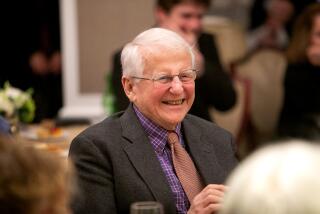DAVID GARRICK by Alan Kendall (St. Martin’s: $19.95; 224 pp., illustrated)
- Share via
To his previous biographers, David Garrick was a theatrical meteor blazing an incandescent trail through the heady atmosphere of 18th-Century England. A celebrated actor, innovative manager of the Drury Lane Theater, author of two enormously successful farces, he was an intimate of the great and near-great, a member of the literary club, including Samuel Johnson, James Boswell and Oliver Goldsmith; his artistic triumphs were lauded and respected by an international array of musicians, artists and statesmen. A tireless correspondent, Garrick’s surviving letters to friends and colleagues fill three substantial volumes, forming a superb chronicle of the social and cultural life of his era.
Living when gossip was a prime diversion, Garrick’s highly public life generated adoration, enmity and a corresponding wealth of anecdote, apocryphal and not. Virtually single-handedly, he restored Shakespeare to pre-eminence with his astonishing performances in “Richard III,” “Macbeth” and “King Lear.” Though he cut and edited the plays, sometimes moving a speech from the end of one to the beginning of another, he never tampered with the language itself. He conscientiously researched the original texts and stripped away the misguided improvements made by 17th-Century zealots who had altered the plays to provide happy endings more agreeable to the sensibilities of the time. Garrick made Shakespeare newly relevant by peaking naturally and insisting his company of actors follow his example, replacing the pompous declamatory mode favored by his predecessors with conversational delivery and relaxed movement. Remarkably versatile, Garrick was enthusiastically acclaimed for his work in comedy and contemporary drama and credited with revolutionizing theatrical lighting and costuming; but perhaps almost as important in that rambunctious age, he succeeded in removing spectators from their traditional seats on stage where they had felt all too free to disrupt the play in progress.
In this revisionist biography, Kendall has peeled away two centuries of accumulated legend to show us a far less flamboyant character. His David Garrick is an efficient and careful businessman, a harried bursar, a faithful doting husband and, eventually, a weary semi-invalid pushing himself beyond endurance, writing mournful letters describing his various physical ailments and financial embarrassments. This Garrick dearly loves a lord, and spends a disproportionate amount of time traveling from one great English house to another, a perpetual quest though a welcome one. “Indeed,” the author comments dryly, “one wonders how so unhistrionic a personality ever achieved what he did in his chosen profession.
“Of course at times he was well able to turn a fine phrase and extract the drama latent in certain situations, but the wonder is that he did so on relatively few occasions, in view of the opportunities presented and the fact that the use of words was his lifeblood--and one must also bear in mind the fact that he lived in an age and milieu where hyperbole was common.”
Here, the brilliant Garrick is not only demystified but denatured; his celebrated romance with the actress Peg Woffington reduced to “an extremely good working relationship,” the fact that he shared a house with her explained away as merely a matter of sound economics; the long, intense love affair sanctimoniously dismissed as a passing fancy. “One cannot imagine a union with even a reformed Woffington being a very enduring one, and the devotion between Garrick and the woman he eventually married indicates that he was the one who believed in, and elicited in return, complete fidelity.”
Of the huge fund of witty letters, the author quotes only the most mundane, creating the impression that Garrick’s correspondence was dominated by recipes for digestive remedies and statements of his accounts. Instead of the magnetic charm and glowing passion, we’re shown practicality and uxoriousness; in place of inspiration, mere plodding diligence.
Page by page, this labored effort methodically turns a shooting star into a dull lump of iron and stone. The miscalculations and disasters in Garrick’s life are described in such detail that his enormous successes begin to seem mere flukes, when precisely the opposite was the case. Garrick’s one out-and-out catastrophe--”The Chinese Festival”--becomes by default the liveliest chapter in the book. A true extravaganza by the standards of the age, with a cast of 90, imaginative sets, gorgeous costumes and elaborate optical illusions, music and ballet, “The Chinese Festival” displeased English audiences not for any shortcoming in the spectacle itself but only because it was originally French, and the traditional hostility between the countries still prevailed. In the general rioting following the performance, hoodlums broke all the windows in Garrick’s house and would have set it on fire if soldiers had not responded to Garrick’s calls for help. The innocent impresario was actually accused of disguising French officers as dancers, and the unfortunate choreographer was rumored to be a pseudonym for the French Prince Charles Edward. Jean Georges Noverre, the distinguished guest, barely escaped England with his life, a departure Kendall dismisses, with characteristic understatement, as a return to France “in something of a fit of the vapeurs.”
The book is generously illustrated with engravings of Garrick and his circle done by Hogarth, Reynolds and other equally gifted and devoted friends of the actor. On Garrick’s death, Samuel Johnson, his teacher and mentor and a man notoriously impatient with mediocrity, wrote: “I am disappointed by that stroke of death, which has eclipsed the gaiety of nations and impoverished the public stock of harmless pleasure.” Alan Kendall, determined to give us a Garrick shorn of glamour, writes: “Possibly he was no great man, except in the history of the theater.” But isn’t that more than enough?
More to Read
The biggest entertainment stories
Get our big stories about Hollywood, film, television, music, arts, culture and more right in your inbox as soon as they publish.
You may occasionally receive promotional content from the Los Angeles Times.










